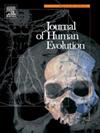Jaw-muscle fiber architecture and skull form facilitate relatively wide jaw gapes in male cercopithecoid monkeys
IF 3.1
1区 地球科学
Q1 ANTHROPOLOGY
引用次数: 0
Abstract
In primates and other mammals, the capacity to generate a wide maximum jaw gape is an important performance variable related to both feeding and nonfeeding oral behaviors, such as canine gape display and clearing the canines for use as weapons during aggressive encounters. Across sexually dimorphic catarrhine primates, gape is significantly correlated with canine height and with musculoskeletal features that facilitate wide gapes. Given the importance of canine gape behaviors in males as part of intrasexual competition for females, functional relationships between gape, canine height, and musculoskeletal morphology can be predicted to differ between the sexes. We test this hypothesis by investigating sex-specific relationships among these variables in a maximum sample of 32 cercopithecoid species. Using phylogenetic least squares regression, we found that of 18 predicted relationships, 16 of the 18 (89%) were significant in males, whereas only six (33%) were significant in females. Moreover, 15 of the 18 correlations were higher—10 of the 18 significantly higher—in males than in females. Males, but not females, showed strong and significant positive allometry of fiber lengths, indicating that increase in male jaw length is accompanied by allometric increases in the capacity for muscle stretch. While males and females showed significant negative allometry for muscle leverage, only males showed significant negative allometry of muscle leverage relative to jaw gape and canine height. Collectively, these results provide support for the hypothesis that as selection acted to increase relative canine height in male cercopithecoids, one change was an allometric increase in relative maximum jaw gape, along with allometric increases in musculoskeletal morphologies that facilitate gape. Lastly, if gape and canine display/clearance are key targets of selection on masticatory morphology in male cercopithecoids, then cercopithecoid monkeys such as macaques, baboons, and sooty mangabeys may have diminished utility as models for drawing paleobiological inferences from musculoskeletal morphology about feeding behavior and diet in fossil hominins.
颚肌纤维结构和头骨形态有利于雄性腕足动物形成相对较宽的颚间隙
在灵长类和其他哺乳动物中,产生宽阔的最大下颌间隙的能力是与进食和非进食口腔行为有关的一个重要的性能变量,例如犬齿间隙显示和在攻击性交锋中清除犬齿以用作武器。在性双态的猫科灵长类动物中,犬齿间隙与犬齿的高度以及有助于形成宽大间隙的肌肉骨骼特征显著相关。鉴于雄性犬齿张开行为是性内争夺雌性的重要手段之一,可以预测犬齿张开、犬身高和肌肉骨骼形态之间的功能关系在两性之间会有所不同。我们在 32 个栉水母类物种的最大样本中研究了这些变量之间的性别特异性关系,从而验证了这一假设。通过系统发育最小二乘法回归,我们发现在 18 个预测关系中,16 个(89%)在雄性中显著,而只有 6 个(33%)在雌性中显著。此外,在 18 种相关关系中,雄性有 15 种高于雌性,其中有 10 种显著高于雌性。雄性(而非雌性)的纤维长度表现出强烈且显著的正异构性,这表明雄性下颌长度的增加伴随着肌肉伸展能力的异构增加。虽然雄性和雌性的肌肉杠杆都表现出显著的负异化作用,但只有雄性的肌肉杠杆相对于下颌角和犬齿高度表现出显著的负异化作用。总之,这些结果为以下假设提供了支持,即随着雄性嵴椎动物相对犬齿高度的增加,其中一个变化是相对最大下颌张开度的异速增加,以及促进张开度的肌肉骨骼形态的异速增加。最后,如果颌骨张开和犬齿显示/清晰度是雄性栉猴咀嚼器形态选择的关键目标,那么猕猴、狒狒和土芒猴等栉猴作为从骨骼肌肉形态推断化石类人进食行为和饮食的古生物学模型的作用可能会减弱。
本文章由计算机程序翻译,如有差异,请以英文原文为准。
求助全文
约1分钟内获得全文
求助全文
来源期刊

Journal of Human Evolution
生物-进化生物学
CiteScore
6.30
自引率
15.60%
发文量
104
审稿时长
3 months
期刊介绍:
The Journal of Human Evolution concentrates on publishing the highest quality papers covering all aspects of human evolution. The central focus is aimed jointly at paleoanthropological work, covering human and primate fossils, and at comparative studies of living species, including both morphological and molecular evidence. These include descriptions of new discoveries, interpretative analyses of new and previously described material, and assessments of the phylogeny and paleobiology of primate species. Submissions should address issues and questions of broad interest in paleoanthropology.
 求助内容:
求助内容: 应助结果提醒方式:
应助结果提醒方式:


